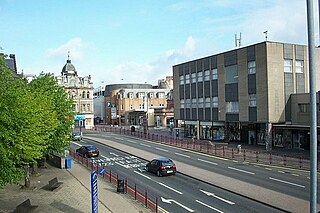
Hamilton is a large town in South Lanarkshire, Scotland. It serves as the main administrative centre of the South Lanarkshire council area. It sits 10 miles (16 km) south-east of Glasgow, 37 miles (60 km) south-west of Edinburgh and 74 miles (120 km) north of Carlisle. It is situated on the south bank of the River Clyde at its confluence with the Avon Water. Hamilton is the county town of the historic county of Lanarkshire and is the location of the headquarters of the modern local authority of South Lanarkshire.

Cadzow Castle, now in ruins, was constructed between 1500 and 1550 at a site one mile south-east of the centre of Hamilton, South Lanarkshire, Scotland. The earlier medieval settlement of Hamilton was formerly known as Cadzow or Cadyou, until it was renamed in 1455 in honour of James Hamilton, 1st Lord Hamilton. The castle sits above a gorge overlooking the Avon Water in what is now Chatelherault Country Park, but was previously the hunting and pleasure grounds of the Duke of Hamilton's estate of Hamilton Palace - this area being known as Hamilton High Parks. The ruin is a Scheduled Ancient Monument.
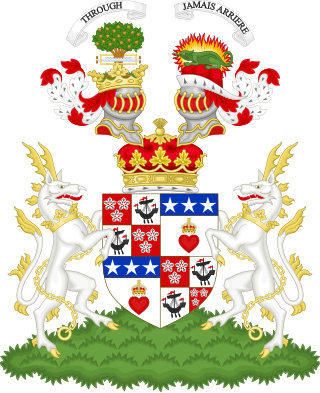
Duke of Hamilton is a title in the Peerage of Scotland, created in April 1643. It is the senior dukedom in that peerage, and as such its holder is the premier peer of Scotland, as well as being head of both the House of Hamilton and the House of Douglas. The title, the town of Hamilton in Lanarkshire, and many places around the world are named after members of the Hamilton family. The ducal family's surname, originally "Hamilton", is now "Douglas-Hamilton". Since 1711, the dukedom has been held together with the Dukedom of Brandon in the Peerage of Great Britain, and the dukes since that time have been styled Duke of Hamilton and Brandon, along with several other subsidiary titles.
Ordinaries in heraldry are sometimes embellished with stripes of colour alongside them, have lumps added to them, shown with their edges arciform instead of straight, have their peaks and tops chopped off, pushed up and down out of the usual positions, or even broken apart.

Duke of Richmond is a title in the Peerage of England that has been created four times in British history. It has been held by members of the royal Tudor and Stuart families.
Lord Belhaven and Stenton, of the County of Haddington, is a Lordship of Parliament in the Peerage of Scotland. It was created in 1647 for Sir John Hamilton, 2nd Baronet, with remainder to his heirs male.
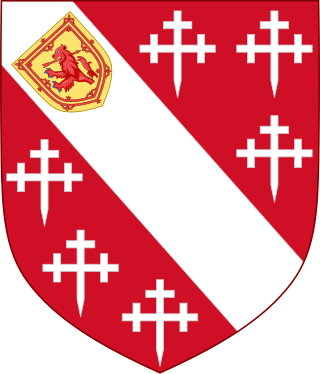
The Howard family is an English noble family founded by John Howard, who was created Duke of Norfolk by King Richard III of England in 1483. However, John was also the eldest grandson of the 1st Duke of the first creation. The Howards have been part of the peerage since the 15th century and remain both the Premier Dukes and Earls of the Realm in the Peerage of England, acting as Earl Marshal of England. After the English Reformation, many Howards remained steadfast in their Catholic faith as the most high-profile recusant family; two members, Philip Howard, 13th Earl of Arundel, and William Howard, 1st Viscount Stafford, are regarded as martyrs: a saint and a blessed respectively.

In heraldry, an ordinary is one of the two main types of charges, beside the mobile charges. An ordinary is a simple geometrical figure, bounded by straight lines and running from side to side or top to bottom of the shield. There are also some geometric charges known as subordinaries, which have been given lesser status by some heraldic writers, though most have been in use as long as the traditional ordinaries. Diminutives of ordinaries and some subordinaries are charges of the same shape, though thinner. Most of the ordinaries are theoretically said to occupy one-third of the shield; but this is rarely observed in practice, except when the ordinary is the only charge.

Bothwell Castle is a large medieval castle, sited on a high, steep bank, above a bend in the River Clyde in South Lanarkshire, Scotland. It is located between Bothwell and Uddingston, about 10 miles (16 km) south-east of Glasgow. Construction of the castle was begun in the 13th century by the ancestors of Clan Murray, to guard a strategic crossing point of the Clyde. Bothwell played a key role in Scotland's Wars of Independence, changing hands several times.

Clan Hay is a Scottish clan of the Grampian region of Scotland that has played an important part in the history and politics of the country. Members of the clan are to be found in most parts of Scotland and in many other parts of the world. However, the North East of Scotland, i.e. Aberdeenshire (historic), Banffshire, Morayshire and Nairnshire Nairn (boundaries), is the heart of Hay country with other significant concentrations of Hays being found in Perthshire, especially around Perth, in the Scottish Borders, and in Shetland.
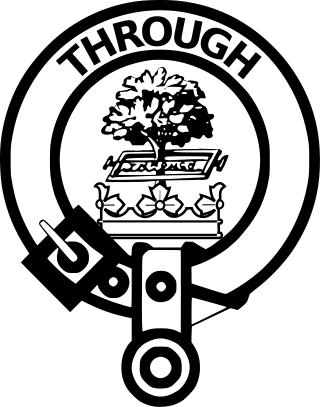
The Clan Hamilton, or House of Hamilton, is a Scottish clan of the Scottish Lowlands.
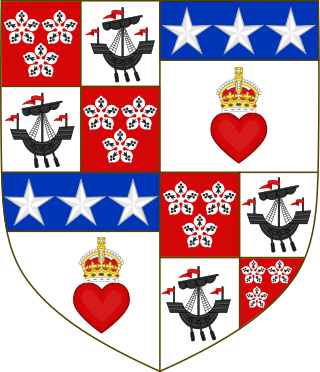
Douglas-Hamilton is the family surname of the Dukes of Hamilton and Earls of Selkirk. The name originates from the marriage of Anne Hamilton, 3rd Duchess of Hamilton to William Douglas, 1st Earl of Selkirk in 1656. Anne was Duchess in her own right and head of the "House of Hamilton". William was a younger son of the Marquess of Douglas.

The Bishop of Hereford is the ordinary of the Church of England Diocese of Hereford in the Province of Canterbury.
Sir David fitz Walter of Cadzow or David fitz Walter fitz Gilbert de Hameldone, 2nd Laird of Cadzow was a Scottish nobleman.
Sir David Hamilton of Cadzow, 3rd Laird of Cadzow was a Scottish nobleman. The son of David fitz Walter fitz Gilbert of Cadzow, he was born at Cadzow Castle, South Lanarkshire.

The Beaumont family was one of the great Anglo-Norman baronial noble families, who became rooted in England after the Norman Conquest.
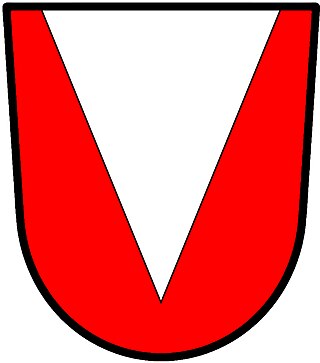
In heraldry, a pile is a charge usually counted as one of the ordinaries. It consists of a wedge emerging from the upper edge of the shield and converging to a point near the base. If it touches the base, it is blazoned throughout.
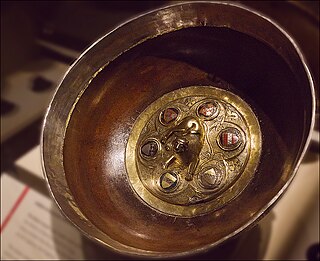
The Bute Mazer, also known as the Bannatyne Mazer is a medieval communal feasting cup of a type known as a mazer. The wood bowl and the elaborate silver-gilt "boss" in the centre are dated "fairly firmly" to between 1314 and 1327 from the heraldry, with the rim and cover about 1500. It is the oldest Scottish mazer still surviving, and one of the oldest and most elaborate British ones. The cup has long been associated with the Isle of Bute, on the west coast of Scotland. Its alternative name derives from Ninian Bannatyne, Laird of Kames, who owned the cup in the 16th century and had his name engraved on the rim. The mazer is now on loan from the Bannatyne family to the National Museum of Scotland in Edinburgh.

Earl of Arran is a title in the Peerage of Scotland. It is not to be confused with the title Earl of Arran in the Peerage of Ireland. The two titles refer to different places: the Isle of Arran in Scotland, and the Aran Islands in Ireland. The Scottish earldom is a subsidiary title of the Duke of Hamilton, whereas the Irish earldom is a separate title held by the Gore family.

Friar Mark Hamilton was a Scottish Dominican and author of a History of the Hamiltons. His kinsman Regent Arran gave Friar Mark Hamilton £4 Scots for a friar's habit on 20 September 1553. Apart from his History and the record of the gift of a habit, few other details of Friar Mark's life are known.